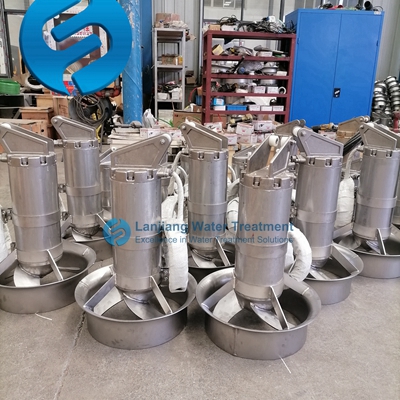Sewage mixer and sludge mixer are different in many aspects, and these differences are mainly reflected in their application scenarios, working principles, structures and design characteristics.

First, application scenarios
Sewage mixer: mainly used in all aspects of sewage treatment plants, such as pretreatment, biological treatment, advanced treatment and sludge treatment, etc., through stirring and mixing, promote the uniform distribution and reaction of suspended matter, organic matter and microorganisms in sewage, improve the efficiency and quality of sewage treatment.
Sludge mixer: It focuses more on the sludge treatment process, especially in the sludge concentration, dehydration, stabilization and other processes play an important role. It improves the fluidity and uniformity of the sludge through stirring and facilitates the subsequent treatment process.
Second, the working principle
Sewage mixer: Usually through the rotating motion of the submersible motor or mechanical mixer, the solid particles in the sewage and the liquid are relative to each other, so as to achieve the purpose of mixing and stirring. Stirring helps to increase the contact area of each component in the sewage and promote the mass transfer and reaction of the substance.
Sludge mixer: Although the principle of mixing is also used, its design pays more attention to the shear and diffusion of sludge. By rotating the spindle in a circular motion, the sludge mixer can produce a strong mixing and mixing effect, which is conducive to the crushing, dispersion and homogenization of the sludge.
Third, structure and design features
Sewage mixer: a variety of structural design, according to the treatment process and the shape of the pool, you can choose different forms of mixer. For example, in a large aeration tank, multiple submersible mixers may be used for distributed mixing. In small tanks, vertical or horizontal agitators may be used.
Sludge mixers: Usually adopt a dual-axis or multi-axis mixing design to provide more powerful mixing and mixing capacity. At the same time, the internal space of the sludge mixer is large, the mixing operation is stable, and the strong mixing effect can be formed. In addition, some sludge mixers also have automatic cleaning and maintenance functions to reduce manual intervention and reduce maintenance costs.
Fourth, other differences
Material and corrosion resistance: Because the sludge may contain more corrosive substances and particles, the sludge mixer is usually more demanding in terms of material selection and corrosion resistance. The sewage mixer is selected according to the specific treatment process and water quality conditions.
Energy consumption and efficiency: There are also some differences between the two in terms of energy consumption and efficiency. The sewage mixer needs to consume a certain amount of energy to overcome the sewage resistance and achieve the mixing effect during operation. The energy consumption and efficiency of sludge mixers may be more affected due to the need to deal with more viscous and complex sludge media. However, with the continuous advancement of technology and the application of new materials, these differences are gradually narrowing.
In summary, there are obvious differences between sewage mixer and sludge mixer in application scenario, working principle, structure and design characteristics. In practical applications, the appropriate mixing equipment should be selected according to the specific treatment process and water quality conditions to ensure the treatment effect and economy.
Nanjing LanJiang Water Treatment Equipment Co.,Ltd manufactures equipment for wastewater treatment. We were established in 2001. Since then, we designed and produced submersible mixers, top entry mixers, aerators and other wastewater treatment equipment.
Post time:2024-09-20